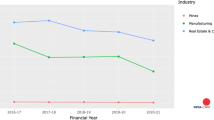Abstract
The recent COVID-19 pandemic has brought multi-layered vulnerabilities across the social, political, humanitarian, ethical, and economic dimensions of people’s everyday lives. While many countries followed strict lockdowns, control on mobility, economic and social activity, and social distancing requirements, India adopted a very stringent lockdown on 24 March 2020, with only four hours of notice given to the entire population (Ghosh in J Ind Bus Econ 47:519–530, 2020).
Access this chapter
Tax calculation will be finalised at checkout
Purchases are for personal use only
Similar content being viewed by others
Notes
- 1.
An unregulated point of meeting or adda for daily wage workers, who visit these points from afar every day in search for daily wage work, mostly in areas of construction, etc.
- 2.
The survey included 200 interviews. However, due to discrepancies in few of the interview, only 195 could be used for the final analysis.
- 3.
The correlation coefficient is a statistical value that measures the relationship and linear interdependence of any two variables. If any two variables are positively correlated, the coefficient will be positive and vice versa, therefore, the value of the correlation coefficient runs from −1 to 1. Squaring the correlation coefficient gives us R2, which measures the strength of the relationship between the two variables and not the direction of the correlation.
- 4.
- 5.
References
Action Aid Association (2020). “Workers in the Time of COVID-19” a report released on survey of 11,537 informal workers across India. 13 August. https://www.actionaidindia.org/press-release/workers-time-covid-19-report-released-survey-11537-informal-workers-across-india/. Accessed on 9 March 2020.
Afridi, F et al (2020). How has Covid-19 crisis affected urban poor? Findings from a phone survey - II. Ideas for India. 11 May. https://www.ideasforindia.in/topics/poverty-inequality/how-has-covid-19-crisis-affected-urban-poor-findings-from-a-phone-survey-ii.html. Accessed 2 March 2021.
Bhalotia, S et al (2020). City of dreams no more: The impact of Covid-19 on urban workers in India. Centre for Economic Performance. September. https://cep.lse.ac.uk/pubs/download/cepcovid-19-008.pdf. Accessed 2 March 2020.
Bromley R (1978). Introduction—The urban informal sector: Why is it worth discussing? World Development 6(9/10): 1033–1039.
Centre for New Economics Studies (2021). Daily wage workers. Youtube. 26 February. https://www.youtube.com/playlist?list=PL8RbNXSvnr8S7Nl6nebNdy5Y22SPs4KHR. Accessed on 20 February 2021.
Cereda et al (2020). COVID-19, labour market shocks, and poverty in Brazil: A microsimulation analysis. World Bank. https://openknowledge.worldbank.org/bitstream/handle/10986/34372/COVID-19-Labour-Market-Shocks-and-Poverty-in-Brazil-A-Microsimulation-Analysis.pdf?sequence=1&isAllowed=y. Accessed 1 March 2021.
CGAP (2020). Relief for informal workers: Falling through the cracks in the COVID-19 crisis. COVID Briefing. August. https://www.cgap.org/sites/default/files/publications/2020.COVID_Briefing_Informal_Workers.pdf. Accessed on 8 March 2021.
CMIE (2020). Unemployment rate in India. https://unemploymentinindia.cmie.com/. Accessed on 10 March.
Estupinan, X and Sharma, M (2020). Job and wage losses in informal sector due to the COVID-19 lockdown measures in India. August 25. https://ssrn.com/abstract=3680379, https://doi.org/10.2139/ssrn.3680379. Accessed on 10 March 2021.
Gerxhani K (2004) The informal sector in developed and less developed countries: A literature survey. Public Choice 120: 267–300.
Ghosh, J (2020) A critique of the Indian government’s response to the COVID-19 pandemic. Journal of Industrial and Business Economics 47: 519–530.
Haan, A (2020) Labour migrants during the pandemic: A comparative perspective. The Indian Journal of Labour Economics 63: 885–900. 19 October.
Hart, K (1973). Informal income opportunities and urban employment in Ghana. The Journal of Modern African Studies 11(1): 61–89.
ILO (2002). Resolution concerning decent work and the informal economy. https://www.ilo.org/public/english/standards/relm/ilc/ilc90/pdf/pr-25res.pdf. Accessed 8 March 2020.
ILO (2018). Women and men in informal economy: A statistical picture. International Labour Office. https://www.ilo.org/wcmsp5/groups/public/---dgreports/---dcomm/documents/publication/wcms_626831.pdf. Accessed on 7 March 2021.
ILO (2020a). COVID-19 and the world of work: Impact and policy responses. 18 March. https://www.ilo.org/wcmsp5/groups/public/---dgreports/---dcomm/documents/briefingnote/wcms_738753.pdf. Accessed on 10 March 2021.
ILO (2020b). Short-term policy responses to COVID-19 in the world of work. International Labour Organisation, New Delhi. 30 March. https://www.ilo.org/wcmsp5/groups/public/---asia/---ro-bangkok/---sro-new_delhi/documents/publication/wcms_739454.pdf. Accessed 1 March 2021.
ILO (2020c). Global wage report 2020c–21: Wages and minimum wages in the time of COVID-19. International Labour Office, Geneva. https://www.ilo.org/wcmsp5/groups/public/---dgreports/---dcomm/---publ/documents/publication/wcms_762534.pdf. Accessed on 6 March 2021.
Mazumdar, D (1976). The urban informal sector. World Development 4(8): 655–679. https://doi.org/10.1016/0305-750X(76)90047-4Economy, Swarajya Magazine. April 22. https://swarajyamag.com/economy/covid-19-lockdown-impact-estimating-the-job-losses-in-indias-informal-economy. Accessed on 10 March 2021.
Mehrotra, S (2019). Informal employment trends in the Indian economy: Persistent informality, but growing positive development, Employment Policy Department Employment Working Paper No. 254, International Labour Office.
Mehta, B and Kumar, A (2020). Covid-19 lockdown impact: Estimating the job losses in India’s informal.
Meng, X (2001). The informal sector and rural–urban migration—A Chinese case study. Asian Economic Journal 15(1): 71–89. https://doi.org/10.1111/1467-8381.00124
Mohan, D et al (2021). Declining wages, no government aid: Daily wage workers are stuck in a deep crisis. The Wire. 28 February.
Perry GE, Maloney WF, Arias OS, Fajnzylber P, Mason AD, and Saavedra-Chanduvi J (2007) Informality: Exit and exclusion. Washington, DC: The World Bank.
Raveendran, G and Vanek, J (2020) Informal workers in India: A statistical profile. Women in Informal Employment: Globalizing and Organizing. August. https://www.wiego.org/sites/default/files/publications/file/WIEGO_Statistical_Brief_N24_India.pdf Accessed on 6 March 2021.
Ray, D and Subramanian, S (2020) India’s lockdown: An interim report. Indian Economic Review. https://doi.org/10.1007/s41775-020-00094-2
Author information
Authors and Affiliations
Corresponding author
Editor information
Editors and Affiliations
Rights and permissions
Copyright information
© 2022 The Author(s), under exclusive license to Springer Nature Singapore Pte Ltd.
About this chapter
Cite this chapter
Mohan, D., Sekhani, R., Mistry, J., Singh, A., Sreedhar, S., Agarwal, S. (2022). Labour Markets of India During a Pandemic: Observations from an Ethnographic Survey: In Cities of Lucknow and Pune Narratives of Daily Wage Workers Across Mazdoor Mandis. In: Nakray, K., Yi, Z., Clammer, J., Zhang, W. (eds) Social and Economic Transitions in China and India. Palgrave Macmillan, Singapore. https://doi.org/10.1007/978-981-19-6124-3_3
Download citation
DOI: https://doi.org/10.1007/978-981-19-6124-3_3
Published:
Publisher Name: Palgrave Macmillan, Singapore
Print ISBN: 978-981-19-6123-6
Online ISBN: 978-981-19-6124-3
eBook Packages: Social SciencesSocial Sciences (R0)




